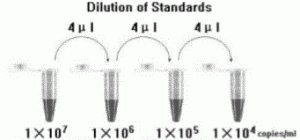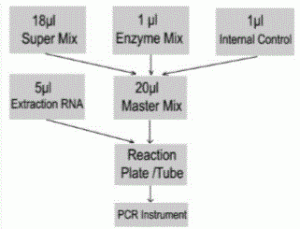1. Intended Use Measles virus real time RT-PCR Kit is used for the detection of measles virus in nasal and pharyngeal secretions and urine samples by using real time PCR systems. This virus can also be detected in many other kinds of samples such as blood, serum, plasma liquor, etc., but not very common. 2. Principle of Real-Time PCR The principle of the real-time detection is based on the fluorogenic 5’nuclease assay. During the PCR reaction, the DNA polymerase cleaves the probe at the 5’ end and separates the reporter dye from the quencher dye only when the probe hybridizes to the target DNA. This cleavage results in the fluorescent signal generated by the cleaved reporter dye, which is monitored real-time by the PCR detection system. The PCR cycle at which an increase in the fluorescence signal is detected initially (Ct) is proportional to the amount of the specific PCR product. Monitoring the fluorescence intensities during Real Time allows the detection of the accumulating product without having to re-open the reaction tube after the amplification. 3. Product Description Measles is one of the most contagious of all human viruses, with about forty million infections world wide each year, and one to two million deaths. Measles outbreaks are common in underdeveloped countries where there is lower socioecoomic status, crowding, and low access to health care. In the third world, there may be up to 900,000 measles related deaths per year. Therefore, there is a lot of pressure on health in different countries in controlling the disease through vaccination. Measles causes rash, cough, and fever, and can lead to ear infection, pneumonia, conjunctivitis, diarrhea, seizures, brain damage, and death. Measles virus real time RT-PCR kit contains a specific ready-to-use system for the detection of the measles virus by Reverse Transcription Polymerase Chain Reaction (RT-PCR) in the real-time PCR system. The master contains a Super Mix for the specific amplification of measles virus RNA. The reaction is done in one step real time RT-PCR. The first step is a reverse transcription (RT), during which the measles virus RNA is transcribed into cDNA. Afterwards, a thermostable DNA polymerase is used to amplify the specific gene fragments by means of polymerase chain reaction (PCR). Fluorescence is emitted and measured by the real time systems ´optical unit during the PCR. The detection of amplified measles virus DNA fragment is performed in fluorimeter channel FAM with the fluorescent quencher BHQ1. In addition, the kit contains a system to identify possible PCR inhibition by measuring the HEX/VIC/JOE fluorescence of the internal control (IC). An external positive control(1×107copies/ml) contained, allows the determination of the gene load. For further information, please refer to section 9.3 Quantitation. 4. Kit Contents Ref. Type of reagent Presentation 25rxns 1 2 3 4 5 MV Super Mix RT-PCR Enzyme Mix Molecular Grade Water Internal Control (IC) MV Positive Control(1×107copies/ml) 1 vial, 480l 1 vial, 28l 1 vial, 400μl 1 vial, 30μl 1 vial, 30μl Analysis sensitivity: 1×103copies/ml; LOQ: 2×103~1×108copies/ml Note: Analysis sensitivity depends on the sample volume, elution volume, nucleic acid extraction methods and other factors .If you use the RNA extraction kits recommended, the analysis sensitivity is the same as it declares. However, when the sample volume is dozens or even hundreds of times greater than elution volume by some concentrating method, it can be much. 5. Storage • All reagents should be stored at -20°C. Storage at +4°C is not recommended. • All reagents can be used until the expiration date indicated on the kit label. • Repeated thawing and freezing (> 3x) should be avoided, as this may reduce the sensitivity of the assay. • Cool all reagents during the working steps. • Super Mix should be stored in the dark. 6. Additionally Required Materials and Devices • Biological cabinet • Vortex mixer • Cryo-container • Sterile filter tips for micro pipets • Disposable gloves, powderless • Refrigerator and Freezer • Real time PCR system • Real time PCR reaction tubes/plates • Pipets (0.5μl – 1000μl) • Sterile microtubes • Biohazard waste container • Tube racks • Desktop microcentrifuge for “eppendorf” type tubes (RCF max. 16,000 x g) 7. Warnings and Precaution Carefully read this instruction before starting the procedure. • For in vitro diagnostic use only. • This assay needs to be carried out by skilled personnel. • Clinical samples should be regarded as potentially infectious materials and should be prepared in a laminar flow hood. • This assay needs to be run according to Good Laboratory Practice. • Do not use the kit after its expiration date. • Avoid repeated thawing and freezing of the reagents, this may reduce the sensitivity of the test. • Once the reagents have been thawed, vortex and centrifuge briefly the tubes before use. • Prepare quickly the Reaction mix on ice or in the cooling block. • Set up two separate working areas: 1) Isolation of the RNA/ DNA and 2) Amplification/ detection of amplification products. • Pipets, vials and other working materials should not circulate among working units. • Use always sterile pipette tips with filters. • Wear separate coats and gloves in each area. • Do not pipette by mouth. Do not eat, drink, smoke in laboratory. • Avoid aerosols

8. Sample Collection, Storage and transport • Collected samples in sterile tubes; • Specimens can be extracted immediately or frozen at -20°C to -80°C. • Transportation of clinical specimens must comply with local regulations for the transport of etiologic agents 9. Procedure 9.1 RNA-Extraction Different brand RNA extraction kits are available. You may use your own extraction systems or the commercial kit based on the yield. For the RNA extraction, please comply with the manufacturer’s instructions. The recommended Extraction kit is as follows: Nucleic Acid Isolation Kit Cat. Number Manufacturer RNA Isolation Kit ME-0010/ME-0012 ZJ Biotech QIAamp Viral RNA Mini extraction Kit (50) 52904 QIAGEN 9.2 Internal Control It is necessary to add internal control (IC) in the reaction mix. Internal Control (IC) allows the user to determine and control the possibility of PCR inhibition. Add the internal control (IC) 1μl/rxn and the result will be shown in the HEX/VIC/JOE. 9.3 Quantitation The kit can be used for quantitative or qualitative real-time RT-PCR. A positive control defined
as 1×10*7

copies/ml is supplied in the kit. For performance of quantitative real-time PCR, Standard dilutions must prepare first as follows. Molecular Grade Water is used for dilution. Dilution is not needed for qualitative real-time PCR detection.
Take positive control (1×10 7
copies/ml) as the starting high standard in the first tube. Respectively pipette 36ul Molecular Grade Water into next three tubes. Do three dilutions as the following figures:
To generate a standard curve on the real-time system, all four dilution standards should be used and defined as standard with specification of the corresponding concentrations. Attention: A. Mix thoroughly before next transfer.
B. The positive control (1×10 7
copies/ml) contains high concentration of the target DNA. Therefore, be careful during the dilution in order to avoid contamination. 9.4 RT-PCR Protocol The Master Mix volume for each reaction should be pipetted as follows:
※PCR system without HEX/VIC/JOE channel may be treated with 1μl Molecular Grade Water instead of 1μl IC. 1) The volumes of Super Mix and Enzyme Mix per reaction multiply with the number of samples, which includes the number of controls, standards, and sample prepared. Molecular Grade Water is used as the negative control. For reasons of unprecise pipetting, always add an extra virtual sample. Mix completely then spin down briefly in a centrifuge. 2) Pipet 20μl Master Mix with micropipets of sterile filter tips to each of the Real time PCR reaction plate/tubes. Separately add 5μl RNA sample, positive and negative controls to different reaction plate/tubes. Immediately close the plate/tubes to avoid contamination. 3) Spin down briefly in order to collect the Master Mix in the bottom of the reaction tubes. 4) Perform the following protocol in the instrument: 45°C for 10min 1cycle Selection of fluorescence channels 95°C for 15min 1cycle FAM Target Nucleic Acid 95°C for 15sec, 60°C for 1min ( Fluorescence measured at 60°C) 40cycles HEX/VIC/JOE IC 5) If you use ABI Prism® system, please choose “none” as passive reference and quencher. 10. Threshold setting: just above the maximum level of molecular grade water. 11.Calibration for quantitative detection: Input each concentration of standard controls at the end of run, and a standard curve will be automatically formed. 12.Quality control: Negative control, positive control, internal control and QS curve must be performed correctly, otherwise the sample results is invalid. Channel Control Ct value FAM HEX/VIC/JOE Molecular Grade Water UNDET 25~35 Positive Control(qualitative assay) ≤35 —— QS(quantitative detection) Correlation coefficient of QS curve≤-0.98 13. Data Analysis and Interpretation The following sample results are possible: Ct value Result Analysis FAM HEX/VIC/JOE 1# UNDET 25~35 Below the detection limit or negative 2# ≤38 —— Positive; and the software displays the quantitative value 3# 38~40 25~35 Re-test; If it is still 38~40, report as 1# 4# UNDET UNDET PCR Inhibition; No diagnosis can be concluded.
For further questions or problems,please contact our technical support at trade@liferiver.com.cn
